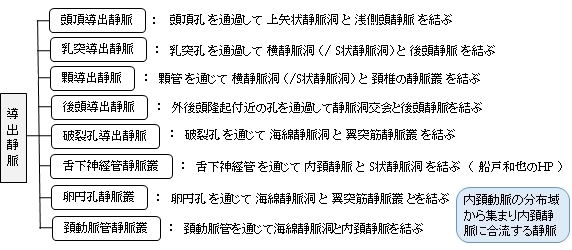
・ 導出静脈には弁がない。( Wikipedia )
・ 通常、血流は頭蓋外から頭蓋内へ流れる。( Wikipedia )
「 日本人体解剖学 」では導出静脈として以下の8つの静脈を挙げている。

注 意 )「 船戸和弥のHP 」では導出静脈を「頭皮の静脈と頭蓋内の静脈(硬膜静脈洞)とを連絡する」としているため、頭頂導出静脈、乳突導出静脈、顆導出静脈、そして後頭導出静脈の4つの静脈の名称を挙げている。また、Wikipediaでは、「 日本人体解剖学 」のように、頭蓋底に開いている孔(卵円孔など)を通して頭蓋の内外の静脈を結んでいるものも導出静脈の1つとしている。
以下は「 Wikipedia 」の解説文となる。
「 The emissary veins connect the extracranial venous system with the intracranial venous sinuses. They connect the veins outside the cranium to the venous sinuses inside the cranium. They drain from the scalp, through the skull, into the larger meningeal veins and dural venous sinuses.
Emissary veins have an important role in selective cooling of the head. They also serve as routes where infections are carried into the cranial cavity from the extracranial veins to the intracranial veins.
There are several types of emissary veins including posterior condyloid, mastoid, occipital and parietal emissary vein.
【 Structure 】
There are also emissary veins passing through the foramen ovale, jugular foramen, foramen lacerum, and hypoglossal canal.
【 Function 】
Because the emissary veins are valveless, they are an important part in selective brain cooling through bidirectional flow of cooler blood from the evaporating surface of the head. In general, blood flow is from external to internal[1] but the flow can be altered by increased intracranial pressure. 」
【 語 句 】
・ extracranial : 頭蓋外の ・ venous sinuses : 静脈洞 ・ cranium : 頭蓋(骨) ・ scalp : 頭皮 ・ meningeal veins : 硬膜静脈 ・ dural venous sinuses : 硬膜静脈洞 ・ infection : 感染症 ・ cranial cavity : 頭蓋腔 ・ condyloid emissary vein : 顆導出静脈 ・ mastoid emissary vein : 乳突導出静脈 ・ occipital emissary vein : 後頭導出静脈 ・ parietal emissary vein : 頭頂導出静脈 ・ foramen ovale : 卵円孔 ・ jugular foramen : 頚静脈孔 ・ foramen lacerum : 破裂孔 ・ hypoglossal canal : 舌下神経管
【 イラスト掲載サイト 】
・ イラストや写真を掲載しているサイト-Ⅰ
・ イラストや写真を掲載しているサイト-Ⅱ
・ イラストや写真を掲載しているサイト-Ⅲ
・ イラストや写真を掲載しているサイト-Ⅳ

|